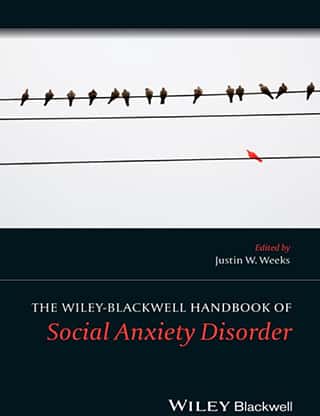We have written a book chapter in a new social phobia “bible”. The book is edited by Justin W. Weeks and is entitled “The Wiley Blackwell Handbook of Social Anxiety Disorder“. The official publication date is April 28th. In our chapter we give an introduction to internet-delivered interventions. Then we give an overview of the different treatment programs that have been developed and tested specifically for social anxiety disorder. We report on the effects of internet-delivered treatments and long-term outcome studies. In addition, the roles of guidance and support and who the therapist should be are commented on. In one section we write about if internet-delivered treatments are as effective as face-to-face treatment for sad and the effectiveness in real clinical settings. Finally, we cover moderators of outcome (what works for whom?).
Referece: Andersson, G., Carlbring, P. and Furmark, T. (2014) Internet-Delivered Treatments for Social Anxiety Disorder, in The Wiley Blackwell Handbook of Social Anxiety Disorder (ed J. W. Weeks), John Wiley & Sons, Ltd, Chichester, UK. [doi: 10.1002/9781118653920.ch26]
Chapters:
- Cognitive-Behavioral Models of Social Anxiety Disorder (pages 1–23)
- Evolutionary Models: Practical and Conceptual Utility for the Treatment and Study of Social Anxiety Disorder (pages 24–52)
- Genetic Factors in Social Anxiety Disorder (pages 53–66)
- The Social Neuroscience of Social Anxiety Disorder (pages 67–89)
- The Pathophysiology of Social Anxiety (pages 90–110)
- Personality: Understanding the Socially Anxious Temperament (pages 111–132)
- Behavioral Inhibition: A Discrete Precursor to Social Anxiety Disorder? (pages 133–158)
- Relational Processes in Social Anxiety Disorder (pages 159–178)
- Social Anxiety Disorder in Children and Adolescents (pages 179–200)
- Comorbidity: Social Anxiety Disorder and Psychiatric Comorbidity are not Shy to Co-Occur (pages 201–222)
- Diversity Considerations in the Assessment and Treatment of Social Anxiety Disorder (pages 223–246)
- Heterogeneity Within Social Anxiety Disorder (pages 247–267)
- Clinical Interviews: Empirical Overview and Procedural Recommendations (pages 269–291)
- Self-Report Assessment: The Status of the Field and Room for Improvement (pages 292–319)
- Cognitive Biases among Individuals with Social Anxiety (pages 321–343)
- Behavioral Deviations: Surface Features of Social Anxiety and What they Reveal (pages 344–365)
- Examining the Controversy Surrounding Social Skills in Social Anxiety Disorder: The State of the Literature (pages 366–387)
- Translational Research in Social Anxiety: Summary of Newest Developments and Future Directions (pages 389–408)
- Positivity Impairment as a Broad-Based Feature of Social Anxiety (pages 409–432)
- Fear of Positive Evaluation: The Neglected Fear Domain in Social Anxiety (pages 433–453)
- The Neuroendocrinology of Social Anxiety Disorder (pages 454–474)
- Cognitive-Behavioral Therapy for Social Anxiety Disorder: The State of the Science (pages 475–497)
- Cognitive-Behavioral Therapy for Social Anxiety Disorder: Applying the Approach (pages 498–520)
- Pharmacological Treatment for Social Anxiety Disorder (pages 521–546)
- Dual Diagnosis Cases: Treating Comorbid Social Anxiety Disorder and Substance Abuse or Dependence (pages 547–568)
- Internet-Delivered Treatments for Social Anxiety Disorder (pages 579–587)
- Acceptance and Mindfulness-Based Therapies for Social Anxiety Disorder: Current Findings and Future Directions (pages 588–607)
[lightbox link=”http://www.carlbring.se/wp/wp-content/uploads/2014/03/SAD_CHAP_26_Weeks.jpg” thumb=”http://www.carlbring.se/wp/wp-content/uploads/2014/03/SAD_CHAP_26_Weeks-725×1024.jpg” width=”725″ align=”center” title=”SAD_CHAP_26_Weeks” frame=”true” icon=”image”]
